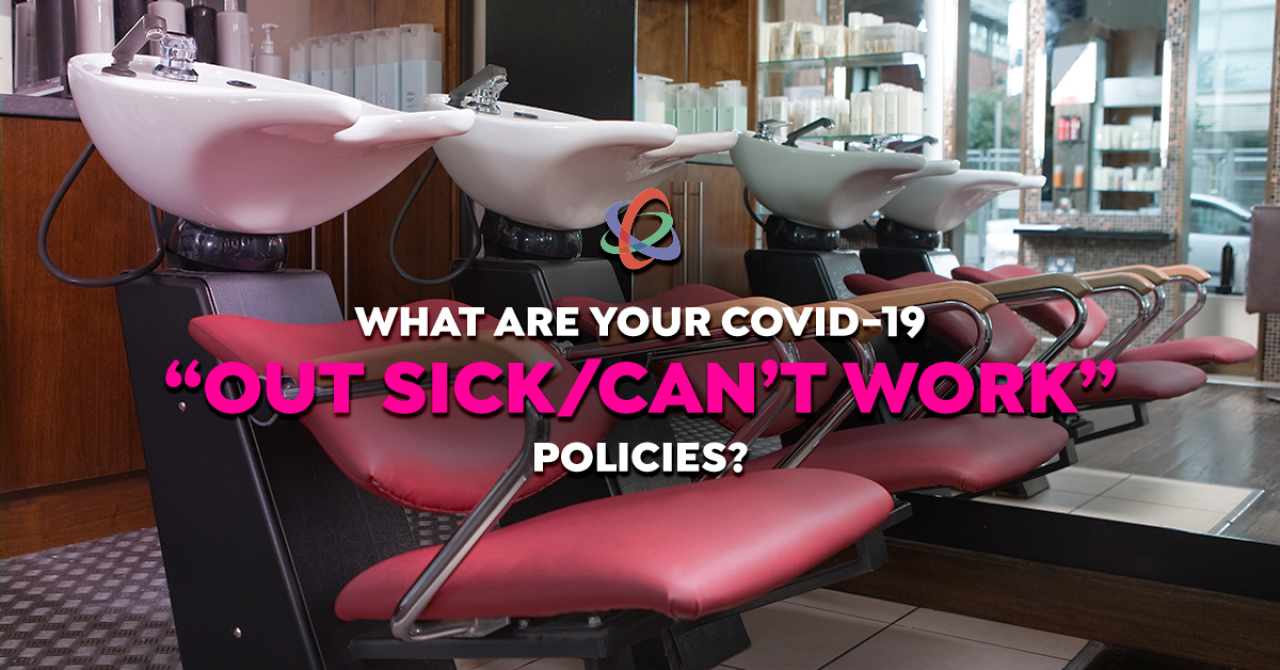What are Your COVID-19 “Out Sick/Can’t Work” Policies?

In last week’s blog post, I gave you six strategies to address the recent increase in last minute cancellations and no shows.
This week, I’m going to address employees calling out with little to no notice and other challenges due to COVID-19.
Andrea Birst is a Strategies Coach and the owner of Glance Salon & Spa in Bismarck, ND. She offers this caution, “Due to the surge of COVID-19, salons/spas need to be prepared to deal with employees that need to stay home. It doesn’t matter if it’s a cough, sinus issue, fever, exposure and/or testing positive for COVID — we cannot have sick, or potentially sick, employees at work.”
Andrea adds, “And there’s all the uncertainty of if, when and how kids go back to school this Fall. Thirteen of our 18 employees are mothers with school age children. We need to be prepared for schedule flexibility.”
FACT: With state mandated safety restrictions on occupancy and capacity, maintaining a high salon/spa productivity rate is essential.
There is a growing concern among owners and employees regarding sick and unable to work policies related to COVID-19.
With COVID-19 surging in many states, it is essential to prepare written policies to avoid any ambiguity, misinterpretation or employee hurt feelings.
The following bullet points are recommendations to help you prepare your salon/spa to address COVID-19 related sick and time off situations. None are etched in stone. Use what works in your company:
- “Sick” means the employee(s) can’t work: Yes, it is frustrating as hell when a service provider with a full schedule calls in sick. In a pandemic, you need to roll with the punches. KEY: Any employee experiencing COVID related symptoms must call in sick and get tested. Employee cannot return to work until he/she tests negative.
- Possible COVID exposure means get tested: The news media is flooded with stories of group gatherings with no social distancing or face masks. It could be a family member or friend that tested positive. KEY: If an employee thinks he/she was possibly exposed, the right thing to do is inform the owner/manager and get tested. Employee cannot return to work until tested negative.
- Travel to a “hot spot” means 14-day self-quarantine: If an employee intends to knowingly travel to a COVID-19 hot spot, even with good reason, it was by choice. KEY: Why take chances bringing the virus into your business? The employee must self-quarantine for 14 days and test negative before returning to work. Self-quarantines are not compensated time off.
- If one employee tests positive: All employees get tested. KEY: This is not being paranoid. It is practicing safety first.
- If a client tests positive: The service provider(s) must get tested. KEY: The employee cannot return to work until tested negative.
- Multiple employees test positive: You’ve got a major problem. KEY: All employees get tested. Follow CDC, state and local guidelines. Unless the infected employees worked on the same shift, the right thing to do is shut your company down until remaining employees are tested. Don’t take chances.
- Kids and school: Employees with school age kids are in a tough position. If schools don’t reopen, or reopen on a staggered schedule, finding and affording childcare may be difficult. KEY: This is a company-wide problem that only teamwork can solve. Schedules will have to be adjusted to accommodate clients. Some employees may need to work extra hours. Maybe one or more employees have access to childcare that can help. Getting through this means working and sacrificing together.
- Hours for sale and productivity rate: Working at reduced capacity is enough of a challenge without employees calling in sick or unable to work. KEY: It is imperative to monitor your company’s hours for sale and hours sold to maintain the highest productivity rate possible. Fewer hours for sale must translate into higher productivity. If not, something is seriously wrong with your systems and culture.
- Revisit service pricing: Pricing services is a math exercise. It factors in all the costs to deliver an hour of service + desired net profit. The cost per hour is heavily influenced by productivity rate. The higher the productivity rate, the better the use of resources, the lower the cost per hour — the higher the net profit. KEY: With mandated reduced capacity, meeting operating expenses and payroll is hard enough. It’s not if, but when, COVID-19 related issues will cause employees to be unable to work. The reality of fewer hours for sale, combined with an already high productivity rate, is going to strain and possibly crush profit. Get your emotions out of your pricing. Charge what you need to charge to get your company through this crisis.
Here’s my challenge to you: The only way for any business to navigate through this pandemic is to be extremely proactive.
It’s no longer an unknown that the virus can find its way into your business.
You need clearly defined policies that every employee understands.
The bullet points presented here are offered as a guide to help you create policies on the most probable “what ifs.” Always base your final action plans on CDC, state and local protocols.
Be prepared to do the right thing — even if that mean temporarily shutting down your company to protect your employees and clients.
Need help? We're here for you. Schedule a free strategy session with one of our Certified Strategies Coaches and we'll help you develop a game plan to level up your business.


Comments
No comments found. Start the conversation!
Leave a Comment